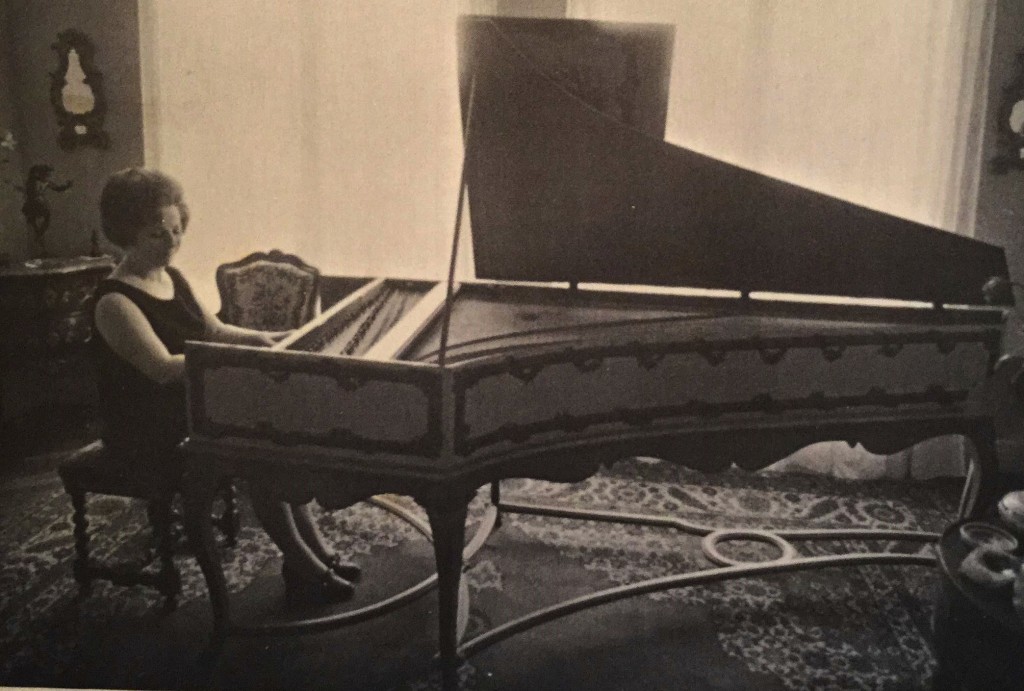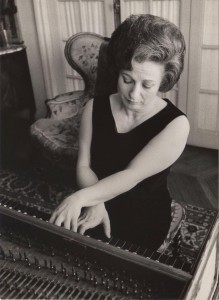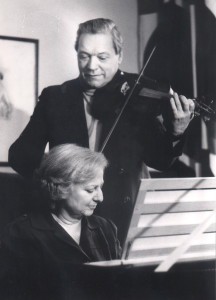
Huguette Dreyfus at home in the early 1960s, playing her Blanchet. From a private collection, all rights reserved.
Guest blogger:
Sally Gordon-Mark, writer/researcher/translator/teacher, was a student and devoted friend of Huguette.
November 30th would have been Huguette Dreyfus’ 88th birthday, but the effervescent concert artist and beloved teacher, the self-proclaimed “inexhaustible chatterbox,” silently slipped away near midnight on May 16, 2016.
It had become customary for organists and harpsichordists to come from all over the world to study with her, Kenneth Gilbert or Gustav Leonhardt. Able to converse with her international students in English, German, French and Italian, she had an enormous gift and love for teaching. She once said her students didn’t need her as much as she needed them.
Listen to Huguette Dreyfus playing Bach’s Concerto No. 3 in d (after Marcello) BWV 974
Please subscribe to this blog – in the top right corner – and receive notifications of new posts by e-mail. In terms of getting information, this is preferable to “liking” the blog (though you can do that too), as Facebook’s money-making system limits the number of people who see our news feed, to as little as 10% of the total sent!
Pauline Huguette was born in Mulhouse (Alsace, France), November 30, 1928 to Fernand and Marguerite Dreyfus. At age 4, she began piano lessons. With her cousin Nicole (later a famous lawyer), and also her older brother Pierre, she played duets and improvised, still a child. Her family was well off, her father an industrialist with factories in Mulhouse and Vichy.
On September 3, 1939, WWII was declared and Jewish families were evacuated from the Alsace region. Fernand took his family to Vichy where he had business interests and friends. Dreyfus enrolled in the Clermont-Ferrand conservatory under a pseudonym, finishing her studies with a first prize in piano. She must have taken on students then, as she said later that she had started teaching at age 14.
In August 1942, the French government turned over more than 6500 Jewish adults and children living in the unoccupied zone to the Nazis; in December, Huguette, her father and brother escaped into Switzerland, according to Swiss records. They settled in Geneva where they had relatives. In 1944 Huguette crossed the border again, apparently alone.
In 1946, Dreyfus and her brother Pierre moved to Paris. At the Ecole normale de Paris, Huguette studied with the great pianist, Lazare-Levy, whose manner of teaching was considered innovative and original with respect to technique, fingering and interpretation.
In 1948, their parents joined her and Pierre. The next year, her father bought a large apartment for the family on Quai d’Orsay near Pont Alma. Huguette would remain there until her death. She studied at the Paris Conservatory for four years, profiting enormously from her class in musical aesthetics with Roland-Manuel, critic and film composer. He had a weekly live radio program on which she often performed.
Dreyfus also felt the same respect and admiration for her music history professor, Norbert Dufourcq – musician, author and lecturer. Dufourcq devoted the year of 1949-50 to the music of Bach, and Huguette’s life changed for good. Dufourcq had managed to procure a small Pleyel; it was the first harpsichord Huguette ever played and a revelation to her.
In 1949, Dufourcq asked Jacqueline Masson, another of his students, to give a harpsichord class, which she did until 1955. Huguette took that class, at least for a year, since it is noted in Conservatory records that on June 6, 1951, she passed the examination with her rendition of Bach’s Toccata, BWV 910.
In 1953, Jacqueline Masson, studying with Landowska’s favorite pupil, Ruggero Gerlin, in Italy, recommended him to Huguette. She and a friend, Anne-Marie Beckensteiner, enrolled in his class and set off for Siena in July 1953, Huguette having won the first of three scholarships from the Academia Chigiana.
Count Chigiani-Seracini established the Accademia in his palazzo in Siena, offering concerts and master-classes from July 15th to September 15th by famous musicians like Andres Segovia and composers like Georges Enesco, whose classes Huguette audited. Every night there were public concerts in the palazzo. Gerlin’s classes were given three times a week; Huguette became his star pupil. As Anne-Marie Beckensteiner remembers, he had her illustrate how to make the music sing, continually praising her hand positions. For Dreyfus, it was a rich, delightful experience and she returned five more summers, giving a total of seven concerts. She later spoke of Gerlin as her only harpsichord teacher.
During this period, her brother gave her a harpsichord built by Nicolas Blanchet, c. 1715, purchased in a shop on Rue Royale in Paris. Because there are few in existence, the American builder William Dowd, a pioneer himself, came to her home to examine it. Contemporary harpsichords were not comparable to historic ones, making the playing experience quite different. Huguette said she learned much about the interpretation of early music from the touch of her instrument.
For an aspiring concert artist, the early music scene was daunting. Music had to be sought in archives; the urtext editions easily available today didn’t exist then. Concert opportunities were few because of the paucity of harpsichords. The first post-war harpsichordists to appear in France were Aimée van de Wiele (on Huguette’s jury in 1951), Marguerite Roesgen-Champion, Marcelle Charbonnier and Pauline Aubert. Jeanne Chomet travelled around France in a van, introducing the harpsichord in places it had never been heard before.
Finalist in the harpsichord competition at the Concours d’exécution musicale in Geneva in October, 1958, Huguette made the daring choice to add pieces from Bartok’s “Mikrokosmos” to her program, having been the first to discover that Bartok intended some pieces to be played on the harpsichord. Her exposure at the Concours launched Huguette’s career; shortly afterwards, she gave her first concert, in Paris, performing sonatas by Scarlatti, whose music she described as “life itself.”
Listen to Huguette Dreyfus playing Scarlatti sonatas
//www.youtube.com/watch?v=rfKw6keEsmk&list=RDrfKw6keEsmk#t=71
Dreyfus’ mentor Roland-Manuel and others spoke about her to Michel Bernstein, owner of the French label, Valois. He had never heard a historic harpsichord before, and when she played her Blanchet for him, he was absolutely dazzled and signed her to a contract. Her first recording was a three-album set of Rameau’s solo harpsichord pieces, not performed since a concert given by Louis-Josèph Diémer at the Paris World Fair in 1889. In 1963, she went abroad for the first time, on a three-week tour of the United States with the Paul Kuentz orchestra.
In the early ’60s, she met harpsichord builder Claude Mercier-Ythier, owner of a harpsichord signed Henri Hemsch (1754). It became Huguette’s favorite instrument and was used whenever possible for her recordings and concerts. They would enjoy a close professional relationship and friendship that would last over 50 years – “a beautiful adventure” he remembers.
Listen to Huguette Dreyfus playing François Couperin – Treizième ordre
In 1963, Dr Pierre Rochas founded the Académie d’Eté at Saint-Maximin-La Sainte-Baume, its Basilique housing a very famous 18th-century organ. It was Mercier who proposed that Huguette give a concert-conference there. It was so successful that the following year, early music classes were organized and something new: concerts from noon to midnight. Among the invited professors was Eduard Melkus, with whom she would record and give concerts, for the next 45 years. Melkus too was in the forefront of the early music revival, dedicating himself to authentic interpretation. He played with Gustav Leonhardt and Nicolas Harnoncourt in Vienna in the 1950s.
Melkus and Huguette met for the first time at St. Maximin. They soon ended up improvising together, creating a complicity “from the first moment” that would continue until their last concert together in 2008. Melkus recalls:
“She was an excellent musician and highly regarded by other musicians. Henryk Szeryng had played with Robert Veyron-Lacroix, but once he played with Huguette, he would never play with any harpsichordist but her. She was the best harpsichordist in France.”
Listen to Henryk Szeryng and Huguette Dreyfus playing Corelli’s “La Folia”
From 1967 to 1990, Huguette taught at the Schola Cantorum in Paris. One of her students was Christophe Rousset, who took his lessons in her home. He dedicated his recently-published biography of François Couperin – “La muse victorieuse” – to Huguette, with whom he was very close.
In 1970, Dreyfus and Valois parted company, when Archiv Produktion invited her to record Bach’s English and French Suites. She would later record for Erato, Deutsche Grammophon-Polydor, Philips, Harmonia Mundi, Barenreiter-Musicaphon, Musifrance, Critère and Denon-Nippon Columbia.
From 1971 until 1982, she taught at the Ecole nationale de musique de Bobigny, where Elisabeth Joyé was in her class, and the Institut de musicologie de Paris-Sorbonne. Then from 1982 to 1994, she worked at the National Superior Conservatories of the Regions of Lyon and of Rueil-Malmaison. Jory Vinikour and Olivier Baumont studied with her in Rueil.
As Jory wrote in a tribute to her soon after her demise:
Although inquisitive and informed on questions of performance practice, she never permitted theory to displace basic mastery of the instrument, stressing phrasing, expressivity, clearly defined polyphony. Less arcane problems were handled with great simplicity – those of us treated to having our hair pulled sharply upwards invariably saw improvement in our postures!
Blandine Verlet, Béatrice Martin, Ilton Wjuniski, Noëlle Spieth, Yannick le Gaillard, Jocelyn Cuiller, Laure Morabito and Yasuko Uyama-Bouvard also studied with Huguette. Many of her professional students continued to play for her before concerts, tours and recording sessions, and most students maintained friendships with the quick-witted, warm-hearted and humorous Huguette.
Every year from 1983 to 1993, and then biannually until 2008, Huguette gave master-classes at the Académie musicale de Villecroze. She continued to give concerts and record CDs. Conrad Wilson, a Scottish music critic, reviewed her performance in Edinburgh (1974): “As an exponent of Rameau, she made a scintillating impression … colouring and ornamenting the music with considerable polish and allure.” A greater compliment still, Henri Dutilleux composed for Huguette an extension of his work “Citations” which she premiered at the Festival of Besançon in 1991.
On May 25, 2008, the city of Mulhouse presented Huguette with a medal in an “Hommage à Huguette Dreyfus.” Invited to give a concert for the occasion, she and Eduard Melkus played a program of music by Bach and Couperin. In November, they also performed together in Vienna. Her final concert was in Japan (2009).
Her recordings received numerous prizes: the Grand Prix du Disque de l’Académie Charles Cros (seven times), the Grand Prix de l’Académie du Disque Français (three times), the Grand Prix des Discophiles, the Prix de la Nouvelle Académie du Disque, and the Prix du Président de la République.
The French government also bestowed honors on Huguette: in 1973, she was declared Officier de l’Ordre national de mérite; on March 4, 1996, Chevalier de la Légion d’Honneur and December 14, 2008, she was promoted to Officier de la Légion d’Honneur. In Austria, she received the title: Officer of Arts and Letters and of Merit of the Austrian Republique.
From 1958 to 2009, she gave concerts in Europe, the U.K., North and South America, Asia, and South Africa. In France, she played in festivals and appeared regularly on radio and television. In January 1997, Huguette performed at the Théatre Grévin in Paris. In Le Monde, Pierre Petit wrote:
Huguette Dreyfus, imperial and faultless, recreated the desired atmosphere every time. [Bach’s The Italian Concerto:] … Dreyfus using with supreme intelligence the opposition of her two keyboards, which brought us a second movement that was particularly moving… [Scarlatti:] With unsurpassable virtuosity, Huguette Dreyfus strung together these unceasingly different pieces in a firework display of joyful and multicolored orginality. It was an absolute triumph, amply merited.
Dreyfus was featured in a 16mm documentary “Le Clavecin” and recorded the soundtracks of two short films. She gave master-classes, served on countless competition and examination juries, and participated in symposiums. Having published articles on Couperin, she also edited “The Goldberg Variations” for Wiener Urtext.

A personal photograph of the late János Sebestyén, graciously provided by Robert Tifft.
Members of the jury of the Concours International de Clavecin de Paris, 1976: FLTR: Huguette Dreyfus, Robert Veyron-Lacroix, Gustav Leonhardt, Ruggero Gerlin, Kenneth Gilbert, and in front, János Sebestyén.
Her legacy was twofold. She left us a large number of rare but findable CDs and LPs
[full discography], recognized as having contributed to the popularity of the harpsichord and the French early music revival. What she imparted to her students however can never be measured.
A more detailed Complete Discography has been compiled by Sally Gordon-Mark.
Acknowledgments
For their kind participation, I thank: Anne-Marie Beckensteiner (interview); Conservatoire Emmanuel Chabrier, Clermont-Ferrand; Françoise Dreyfus (interview); Stephanie Gray, Johnston Press PLC; Eduard Melkus (interview); Claude Mercier-Ythier (interview); Miriam Pizzi, l’Accademia Chigiana; Didier Schnorhk; Robert Tifft and Frank Trnka.
Memorial concert
A memorial concert to be held on 5 May 2018, played by her former students, is being organized. If you would like to participate or attend, please contact Sally Gordon-Mark, sally.gordonmark[at]dartybox.com
Copyright © 2016 Sally Gordon-Mark – All Rights Reserved



merci de cet article très complet sur notre chère Huguette, et merci de me faire savoir ce que vous avez l’intention d’organiser à sa mémoire…..
(elle m’a demandé pour assistante au CNSMD de LYON dès Janvier 83 et j’ai eu le grand honneur de prendre sa suite lors de son départ en 94 !)
A bientôt donc
Françoise Lengellé.
I wish you to add the name of Mariko Oikawa as a Japanese student. Though she died young, she was the first Japanese student before Yasuko Uyama.
Dear Shigeru, I have added her name to my new article, the one I started after having spoken with you and others, and doing more research. I am sorry, but I cannot change this article where there is a limit on the number of words. When I wrote it, I didn’t know about Mariko, unfortunately.